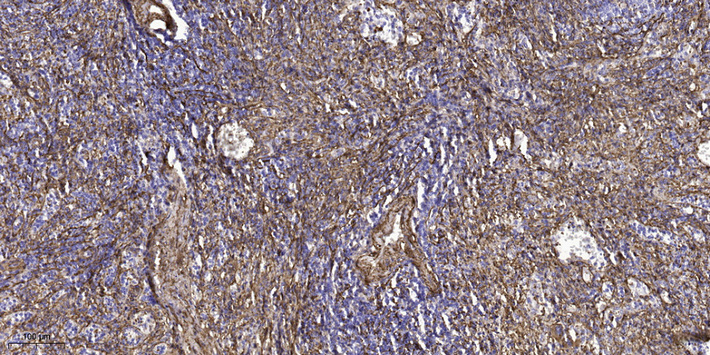USH2A rabbit pAb
- Catalog No.:YT6719
- Applications:IHC;IF
- Reactivity:Human;Mouse;Rat
- Target:
- USH2A
- Gene Name:
- USH2A
- Protein Name:
- USH2A
- Human Gene Id:
- 7399
- Human Swiss Prot No:
- O75445
- Mouse Gene Id:
- 22283
- Mouse Swiss Prot No:
- Q2QI47
- Rat Gene Id:
- 289369
- Rat Swiss Prot No:
- Q8K3K1
- Immunogen:
- Synthesized peptide derived from human USH2A AA range: 3731-3781
- Specificity:
- This antibody detects endogenous levels of USH2A at Human/Mouse/Rat
- Formulation:
- Liquid in PBS containing 50% glycerol, 0.5% BSA and 0.02% sodium azide.
- Source:
- Polyclonal, Rabbit,IgG
- Dilution:
- IHC 1:50-200. IF 1:50-200
- Purification:
- The antibody was affinity-purified from rabbit antiserum by affinity-chromatography using epitope-specific immunogen.
- Concentration:
- 1 mg/ml
- Storage Stability:
- -15°C to -25°C/1 year(Do not lower than -25°C)
- Molecular Weight(Da):
- 572kD
- Background:
- This gene encodes a protein that contains laminin EGF motifs, a pentaxin domain, and many fibronectin type III motifs. The protein is found in the basement membrane, and may be important in development and homeostasis of the inner ear and retina. Mutations within this gene have been associated with Usher syndrome type IIa and retinitis pigmentosa. Multiple transcript variants encoding different isoforms have been found for this gene. [provided by RefSeq, Dec 2008],
- Function:
- disease:Defects in USH2A are the cause of retinitis pigmentosa type 39 (RP39) [MIM:268000]. RP leads to degeneration of retinal photoreceptor cells. Patients typically have night vision blindness and loss of midperipheral visual field. As their condition progresses, they lose their far peripheral visual field and eventually central vision as well. RP39 inheritance is autosomal recessive.,disease:Defects in USH2A are the cause of Usher syndrome type 2A (USH2A) [MIM:276901]. USH is a genetically heterogeneous condition characterized by the association of retinitis pigmentosa and sensorineural deafness. Age at onset and differences in auditory and vestibular function distinguish Usher syndrome type 1 (USH1), Usher syndrome type 2 (USH2) and Usher syndrome type 3 (USH3). USH2 is characterized by congenital mild hearing impairment with normal vestibular responses.,domain:The PDZ-binding motif
- Subcellular Location:
- Cell projection, stereocilium membrane ; Single-pass type I membrane protein . Component of the interstereocilia ankle links in the inner ear sensory cells. In photoreceptors, localizes at a plasma membrane microdomain in the apical inner segment that surrounds the connecting cilia called periciliary membrane complex. .; [Isoform 2]: Secreted.
- Expression:
- Present in the basement membrane of many, but not all tissues. Expressed in retina, cochlea, small and large intestine, pancreas, bladder, prostate, esophagus, trachea, thymus, salivary glands, placenta, ovary, fallopian tube, uterus and testis. Absent in many other tissues such as heart, lung, liver, kidney and brain. In the retina, it is present in the basement membranes in the Bruch's layer choroid capillary basement membranes, where it localizes just beneath the retinal pigment epithelial cells (at protein level). Weakly expressed. Isoform 2 is expressed in fetal eye, cochlea and heart, and at very low level in brain, CNS, intestine, skeleton, tongue, kidney and lung. Isoform 2 is not expressed in stomach and liver. In adult tissues, isoform 2 is expressed in neural retina and testis,
- June 19-2018
- WESTERN IMMUNOBLOTTING PROTOCOL
- June 19-2018
- IMMUNOHISTOCHEMISTRY-PARAFFIN PROTOCOL
- June 19-2018
- IMMUNOFLUORESCENCE PROTOCOL
- September 08-2020
- FLOW-CYTOMEYRT-PROTOCOL
- May 20-2022
- Cell-Based ELISA│解您多样本WB检测之困扰
- July 13-2018
- CELL-BASED-ELISA-PROTOCOL-FOR-ACETYL-PROTEIN
- July 13-2018
- CELL-BASED-ELISA-PROTOCOL-FOR-PHOSPHO-PROTEIN
- July 13-2018
- Antibody-FAQs
- Products Images

- Immunohistochemical analysis of paraffin-embedded human spleen tissue. 1,primary Antibody was diluted at 1:200(4° overnight). 2, Sodium citrate pH 6.0 was used for antigen retrieval(>98°C,20min). 3,Secondary antibody was diluted at 1:200



